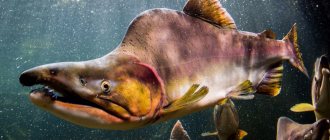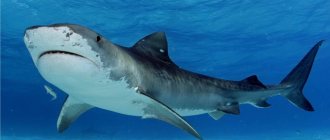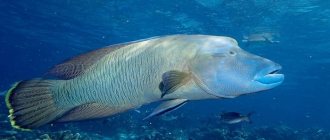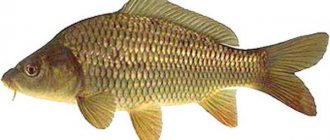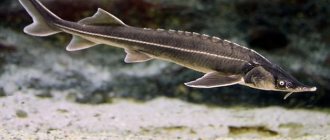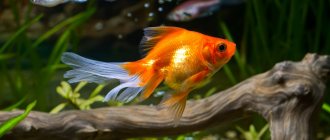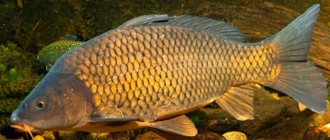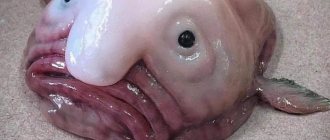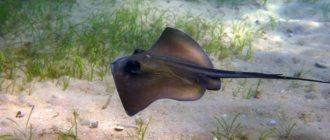Flounder fish: description
Due to the fact that the eyes of this order are located on the right side, they are also called “Right-sided flounders”. It is also known that there are forms of flounder in which the eyes are located on the left side of the head. The symmetrically located pelvic fins have a rather narrow base.
All varieties of flounder are characterized by general data, such as:
- Having a flat body shape.
- Elongated dorsal and anal fins with many rays.
- Asymmetrical head.
- Closely spaced, convex eyes that can function independently of each other.
- The lateral line that runs between the eyes.
- A slanted mouth and fairly sharp teeth.
- Quite a short tail.
- The opposite side is distinguished by its light color and strong, rough skin.
Flounder eggs are distinguished by the fact that they do not have a fat drop, so they are suspended in the water column, where the development of future offspring occurs. Five species of flounder prefer to spawn in the bottom region.
Interesting moment! The ability of this family to mimicry allows them to skillfully camouflage themselves, regardless of the complexity of the background color. At the same time, “Flounders” are not inferior in their camouflage capabilities even to a chameleon.
Appearance
All varieties of flounder prefer to lead a benthic lifestyle at considerable depth. Their characteristic distinguishing feature is the presence of a thin, oval or diamond-shaped body, as if flattened laterally.
River flounder (Platichthys flesus) is a term that defines such species of flounder as Star, Black Sea (kalkan) and Polar.
- The star flounder is distinguished by the fact that it is characterized by a left-sided position of the eyes. In this case, the fish has a dark, greenish or brown body color, with wide black stripes on the fins and spiked star-shaped plates. This is typical for the side where the eyes are located. The fish grows up to 60 cm in length and can weigh up to 4 kilograms.
- Black Sea Kalkan . Represents a flounder with left-sided eyes. On the round-shaped body you can see many tuberous spines, which are randomly scattered throughout the body on the left side. The main body color is brown-olive. Flounder grows to a length of more than one meter, gaining weight up to 20 kilograms.
- Arctic flounder . It is a cold-resistant representative of a large family. It is distinguished by an elongated oval-shaped body. The body color is uniform and made in dark brown tones, while the color of the fins has a brown tint.
Varieties of sea flounder thrive in salt water, in addition, they are distinguished by the fact that they have a wide range of data regarding their size, body shape, fin color, as well as the location of the eyes.
- The common flounder has a basic color of brown-green, with spots of a reddish or orange tint. Adult specimens can weigh up to 7 kilograms and grow up to 1 meter in length. The species has excellent capabilities in terms of mimicry.
- White-bellied southern and northern flounder are marine fish that lead a bottom-dwelling lifestyle. They can grow up to half a meter in length. A characteristic feature of this species is the presence of a bifurcated lateral line, arched in shape. The lower part of the fish's body is milky in color, and the upper part is brown or wheat-brown.
- Yellowfin flounder is a cold-loving species. The body is round in shape, covered with scales with tiny spines. The fins have a yellow-golden hue. Adult specimens grow up to 0.5 meters in length and weigh no more than 1 kilogram.
- Halibut . The variety is represented by 5 species. Some of them are up to 4 and a half meters long and weigh up to 350 kilograms. The arrow-toothed halibut is considered the smallest representative, with a length of no more than 0.8 meters and a weight of about 8 kilograms.
The name Far Eastern flounder is applied to individual subspecies representing the so-called flat fish.
This fish came straight out of a Picasso painting - Tropical flounder botus
Character and lifestyle
These fish prefer to lead an isolated bottom lifestyle, and they are able to camouflage themselves very skillfully, depending on the nature of the surrounding landscape. They spend most of their lives in a lying position either on the surface of the soil or in the thickness of the soil, burying themselves in it almost completely, with the exception of their eyes, which are always on the surface. This type of life activity allows the fish not only to reliably hide from its enemies, but also to obtain food for itself by attacking its prey from a kind of ambush.
At first glance, it seems that this fish is slow and clumsy, since it is mainly seen slowly moving through the water column, at a considerable distance from the bottom. In fact, if necessary, a flounder can demonstrate its skills by instantly gaining decent speed.
In case of danger, the fish makes an instant leap forward several meters due to a very powerful jet of water, which is formed by the gill cover. This jet literally “shoots” into the bottom area. As a result, a cloud of turbidity is formed, which gradually settles to the bottom. During this time, the fish manages to grab its prey or escape from the predator.
How long does flounder live?
Flounder can live, if favorable conditions are created for this, for at least 30 years. Being in the natural environment, flounder rarely survives to such a respectable age, since the bulk ends up in industrial fishing nets.
Sexual dimorphism
Male flounder can be distinguished from females by several characteristics. Firstly, they are smaller in size and weight, and secondly, they have a larger distance between the eyes. In addition, they have longer rays of the pectoral and dorsal fins.
Features of character and lifestyle
Photo: Flounder in the sea
Basically, all flounders lead a solitary bottom life. In terms of camouflage, they are consummate professionals. Fully adapting to the surrounding area (the ability of mimicry). They spend the lion's share of their fish time lying down on the bottom or in the thickness of the soil, buried right up to their eyes. This helps to remain unnoticed by large predators and skillfully capture fish prey from ambush.
At first glance, flounder may seem clumsy and slow; it slowly glides along the surface of the ground with wave-like movements. The flat fish behaves this way when it does not feel any threats, but if there are reasons for this, then the fish instantly transforms into a fast swimmer, the start of which is simply lightning fast, and the speed in a short period of time develops quite decent.
When the situation requires it, the flounder, like a bullet, makes a powerful jerk of its flattened body, which instantly moves the fish a distance of several meters in the desired direction, while with the help of the gill cover the flounder releases a powerful stream of water towards the bottom, thereby lifting the turbidity from it . While it disperses, the cunning flounder can manage to catch its favorite prey or hide from predatory eyes, although it is already very difficult to notice the fish, because it blends into the landscape.
Interesting fact: While conducting an experiment, scientists covered the bottom of the aquarium where the flounder lived with a special substrate painted in black and white checkered patterns. After a short time, clearly visible spots of both dark and light colors appeared on the fish’s body.
Types of flounder
The currently known 60 species of flounder are represented by 23 genera:
- The spiny flounder genus includes the Spiny flounder and the Reliable flounder.
- The genus of arrowtooth halibut is represented by the Asian arrowtooth halibut and the American arrowtooth halibut.
- The genus of sharp-headed flounder includes the Herzenstein flounder and the sharp-headed flounder.
- The genus Warty flounder consists of one species called Warty flounder.
- The genus Eopsetta is represented by the Far Eastern flounder (Grigoriev's flounder) and Jordan's flounder.
- The genus "Long flounder" consists of such species as the Red flounder and the Far Eastern long flounder (Steller's smallmouth).
- The genus of halibut flounder consists of such species as Japanese halibut flounder (Japanese flounder), Northern halibut flounder, Ruff flounder and Bering Sea flounder.
- The genus "Halibuts" (white halibuts) consists of the Atlantic halibut and the Pacific halibut.
- The genus of two-colored flounder and two-lined flounder is represented by such species as the white-bellied flounder and the northern two-lined flounder.
- The Limanda genus includes several more species and is represented by the yellowfin flounder, yellow-tailed Limanda, Ruffed Limanda, Long-snouted Limanda and Sakhalin flounder.
- The genus “Polar flounder” is represented by one species – the naked-headed flounder.
- Genus "Oregon flounder".
- The genus Smallmouth Flounder is represented by several species, including smallmouth flounder and Pacific smallmouth.
- The genus “River flounder” is also represented by several species, including the Star flounder.
- The genus "Sea flounder" includes several species, including the species Yellow sole.
- The genus of hardhead flounder includes the species Horned Flounder.
- Genus of spotted flounder.
- The winter flounder genus includes species such as Yellowband flounder, Schrenk flounder and Japanese flounder.
You should pay attention to such genus as Dexists and Embassichts, which includes the Deep-sea Embassicht, as well as the genus Isopsets, Veraspets, Tanakius, Psalmodiscus, Parophrys and Black Halibuts.
Interesting to know! Halibuts are considered the largest representatives of the family that live in the Pacific and Atlantic oceans. Halibuts live for about half a century, populating great depths.
Lifestyle
Sea flounder can be classified as a predatory fish. The special coloring helps it hunt and survive. As a rule, flounder moves along the bottom and can bury itself in sand and small pebbles so that only its eyes are visible.
On average, its length is 60 cm, maximum weight is 7 kg. Flounder can be classified as a fish with a good life expectancy - about 30 years.
Flounder feeds on small fish and shellfish, namely: sprats, sprat, fry, anchovy and even shrimp.
Natural habitats
Some species have shown a preference for the northern latitudes of the Pacific depths, with many of them found in the Seas of Japan, Bering, Okhotsk and Chukchi Seas. For freshwater forms, typical habitats are lagoons, lower reaches of rivers and bays. For some species, distribution within the northern latitudes of the Atlantic, as well as within the waters of the Black, Baltic and Mediterranean seas is considered typical. Some species thrive not only in the marine environment, but also in the lower reaches of rivers such as the Southern Bug, Dnieper and Dniester. Due to the fact that the Sea of Azov has recently become too salty, and the inflowing rivers have become noticeably shallower, the Black Sea flounder kalkan chose to migrate to the mouth of the Don River. Cold-resistant species, as a rule, live in arctic latitudes, found in the waters of the Kara, Barents, White, Bering and Okhotsk seas. At the same time, they swim into rivers such as the Yenisei, Ob, Kare, Tugura, where they prefer places with soft silty soils.
Marine varieties of flounder inhabit low- and high-salinity waters, living at depths up to 200 meters inclusive. Many of the species are considered valuable commercial fish, and they are found in the waters of the Eastern Atlantic, as well as seas such as the Mediterranean, Barents Sea, White and Baltic. The southern white-bellied flounder is characterized by its distribution in the waters of the Sea of Japan, and some northern subspecies are limited to the waters of the Okhotsk, Kamchatka and Bering seas.
Interesting moment! Flat fish are distinguished by rich species diversity and enormous biological flexibility, which allowed them to spread across territories located along the entire Eurasian continent, as well as in the waters of inland seas.
Yellowfin flounder is widespread in the waters of the Sea of Japan, Okhotsk and Bering Sea. Large populations of this species are distributed within Sakhalin and the western waters of Kamchatka, where they live at depths of up to 80 meters, preferring the benthic region. Typical habitats for halibut fish are the waters of the Arctic Ocean and the Pacific Ocean, including the waters of the Barents Sea, Bering Sea, Okhotsk and Japan Seas.
How to select and store
Flounder can absorb and accumulate salts of heavy metals in its body if the ecology in the places where it is caught is unfavorable. You need to buy the product at specialized sales points, checking quality certificates. The following signs indicate freshness:
- pleasant sea scent;
- clean pink gills;
- the upper part of the carcass is bright, without a red tint;
- dense, elastic meat that returns to its original shape after pressing;
- the scales are rough to the touch, without a slimy film;
- eyes are transparent, not cloudy.
In coastal towns you can buy both fresh frozen and live flounder. It is better to keep fresh fish in ice, putting it in the refrigerator, but no more than 2 days. It is easy to increase the storage time by sprinkling the carcasses with coarse salt. They do not spoil in the freezer for 3-4 months. Thawed fish cannot be re-frozen.
What does flounder eat?
These fish go hunting either at dusk, or at night, or in the morning. Flounder is considered a predatory fish, so its diet consists of animal foods. At a young age, individuals feed on benthos, amphipods, various worms, larvae, crustaceans and eggs. As they grow older, flounder switches to larger worms, brittle stars, echinoderms, as well as small fish, many invertebrates and crustaceans. Particularly popular among representatives of this family are shrimp and medium-sized capelin.
Due to the structural features of the body, which is associated with the lateral position of the head, this fish can easily reach various mollusks from the thickness of the sea or river bottom. At the same time, it should be noted that the jaws of the flounder are strong and powerful, so the fish can easily deal with even the shells of crabs. Due to the fact that the family feeds on food items high in protein, fish is of great value.
Nutrition
Each subspecies of flounder feeds at different times of the day. One during the day, the other at night. It depends on the area and preferred habitat. Basically, these representatives of the fauna feed on food of animal origin, but if nothing was caught, they will happily feast on vegetation.
Also, the diet of flounder depends on its age. For example, young males feed on the eggs of other fish, small crustaceans, amphipods, benthos, worms, larvae, and aquatic insects.
Older individuals prefer to feed on fry and small fish, worms and other representatives of the echinoderm family, small animals from the invertebrate family, brittle stars, and crustaceans. The most favorite delicacy for flounder is shrimp, as well as capelin.
Thanks to the unusual position of the head, namely its lateral placement on the body, the fish can calmly gnaw small mollusks and other inhabitants of the aquatic depths from the bottom.
Sharp teeth also help her pull them out. Flounder is also distinguished by its strong jaws. It can easily cut through the shells of crabs or the shells of oysters, clams and others. For normal functioning, this type of fish requires systematic feeding with high-protein foods.
Reproduction and offspring
The periods of spawning largely depend on living conditions, which is associated with the onset of spring, warming up of the water column, etc. As a rule, many species spawn between the first ten days of February and May, although there are some exceptions.
The large diamondfish (turbot) prefers to spawn in the waters of the Baltic and North Seas, starting from April and including the month of August. As for the polar flounder, the process of its spawning occurs in the water column covered with ice, and the period occupies the period from December to January inclusive.
Depending on the species, the ability to reproduce occurs after a minimum of 3 years of life. Many species are characterized by a high degree of fertility, so the number of eggs in a clutch can range from several hundred thousand to several million. As a rule, the period of development of eggs takes no more than a couple of weeks. To spawn, flounder chooses places with sufficient depth and a sandy bottom.
Important point! The flounder fry that are born have a body shape that is familiar to fish, since they are characterized by symmetrically developed sides, since the eyes are located classically, on both sides of the head. Frying flounder eat zooplankton and other small food items.
Some species prefer areas up to 50 meters deep, which is due to the excellent buoyancy of the eggs, as well as the lack of need for attachment to any foundation.
Giant turbot fish underwater. Giant halibut/flounder underwater.
Pregnant and lactating
Flounder can be consumed by pregnant women. It contains a lot of iodine, which promotes the favorable development of the fetus and prevents thyroid dysfunction. It is recommended to eat 150 g of fish pulp per day for symptoms of acute toxicosis, especially in the later stages. Helps replenish strength during the postpartum period.
It contains enough vitamins that the female body needs so much in preparation for pregnancy. Polyunsaturated fats prevent pelvic diseases and stimulate the production of hormones necessary for conception and gestation.
During the lactation period, beneficial substances are transferred from mother's milk to the newborn.
Natural enemies
Thanks to its abilities, the flounder fish changes its body color depending on the color of the bottom of the reservoir. This allows the fish to go unnoticed by many predators. This does not mean that the fish is completely devoid of natural enemies. The most dangerous for it are halibut, eel and humans. The fish has quite tasty, delicious meat, so it is caught in large quantities in all areas of the World Ocean.
What is better to eat?
The choice of fish depends on the method of its preparation. Salty, dried product should not be consumed for certain diseases. Boiled meat is healthy at any age, and there are separate recommendations for fried meat.
For children
The benefits of sea fish for children's bodies are as follows:
- protection against malfunctions of the thyroid gland;
- prevention of musculoskeletal disorders;
- strengthening tooth enamel, helping in the correct formation of the bite;
- replenishment of energy needed at school age.
Fish products on a schoolchild's menu help develop attention, memory and prevent vision impairment.
Ground boiled fillet is introduced into the diet from one year onwards. Steamed fish cutlets and broth are suitable for small children. From 3 years old, baked sea fish and vegetables can be included in the children's menu. Fried and smoked sea ruffe should not be included in the diet of a child under 7 years of age.
For adults
Eating flounder and ruffe dishes supports women's health, normalizes hormonal levels and prevents pelvic diseases. Thanks to antioxidants, it is recommended to eat fish products when working in hazardous industries. It is also useful to include marine meat in the menu during increased physical activity, constant stressful situations, and mental stress.
All types of fish dishes are healthy in moderation. Sea ruff in the form of a beer snack is suitable for a weekend lunch. Boiled and fried fish should be consumed twice a week.
Pregnant and lactating
Sea ruff and common flounder are equally useful during pregnancy:
- the high content of omega-3 acids in the product contributes to the proper development of the embryo;
- Iodine, which meat is rich in, helps improve the functioning of the thyroid gland;
- antioxidants alleviate toxicosis.
A fish diet restores strength after childbirth, helps prevent vitamin deficiency, and replenishes the loss of phosphorus and calcium. Seafood is useful for preventing the development of edema and varicose veins.
Eating boiled and fried fish and soups during breastfeeding helps saturate milk with microelements that help strengthen the child’s immune system, nervous system and spine.
Expert opinion
Karnaukh Ekaterina Vladimirovna
Graduated from the National University of Shipbuilding, majoring in Enterprise Economics
Salted and dried fish are useful in small quantities in the early months of pregnancy. But you should not overuse a specific product, so as not to provoke bloating and heartburn.
For people of advanced age
Boiled, steamed and fried flounder reduces the risk of gout, prevents joint inflammation and the development of osteoporosis. Seafood on a regular menu helps normalize blood pressure and intestinal function. Fish dishes speed up metabolism and are useful for preventing dementia.
Fried or smoked sea ruffe is an undesirable burden on the gastrointestinal tract in old age. It is better to prepare soups, cutlets from the meat of scaly bottom fish, and boil the fillets after removing the skin.
For chronic diseases
Salted, fried and smoked sea ruffe is not a recommended food additive for diseases of the stomach and intestines. For gastritis, it is useful to eat soft steamed flounder fillet. Omega acids lower cholesterol and promote healing of inflammation.
Boiled smooth sea fish fillet will alleviate the course of autoimmune diseases and cholecystitis. Regular use of the product will help calm the nervous system and normalize sleep. If you have diabetes, it is better to give preference to flounder without scales. The substances contained in the product strengthen blood vessels, which is also useful for vein diseases.
For people on a diet
Boiled flounder is the best option for normalizing weight. Fish is included in the protein diet. Low fat content, a set of essential vitamins help you lose weight, develop muscles, strengthen ligaments and replenish energy. Fish dishes are necessary in the diet of athletes.
Sea fish fillet is included in therapeutic diets after operations, radiation and chemotherapy, and treatment of gastric disorders.
Population and species status
Currently, there are many problems associated with everyday fishing for many valuable fish species. The main problem is related to overfishing of easily accessible and, especially, scarce species. This problem has deep roots and is associated with multi-species fisheries. Unfortunately, it has not yet been possible to solve this problem. The total number of flounder depends on many natural factors, so experts note a certain cyclicity, characteristic both for conditions of declining and increasing populations.
These factors include the constant negative impact of humans associated with their life activities, including the fact that humans exert enormous pressure as a result of commercial, uncontrolled fishing. As an example, we can take the Arnoglos Mediterranean flounder and the Kessler flounder, which are on the verge of complete extinction, so their total numbers are extremely small.
Interesting Facts
If we turn to German folklore, then in a similar Russian fairy tale “About the Fisherman and the Fish,” an old fisherman caught a real sea monster with his nets. According to the description, it is very reminiscent of a flounder, because the flat body and the location of the eyes on one side are characteristic only of representatives of this species.
The beneficial properties of its meat surpass those of other fish. For example, it contains a huge amount of fatty acids necessary for the human body, which can easily replace artificial vitamins.
It contains a huge amount of protein, the digestibility of which is many times greater than that of chicken or beef. That is why it is very useful for use by children and pregnant women.
Also, some experts note that flounder has special properties inherent in many aphrodisiacs. That is, its meat contributes to the development of sexual potential and increased libido. Only some fish can boast of the same properties.
- Jacques Picard, during his famous dive to the bottom of the Mariana Trench, whose depth is 11 km, noted in his notes that there is life at such a depth.
- And among the inhabitants of the ocean depths, his attention was attracted by very small fish, the length of which barely exceeded 30 cm, similar in appearance to flounder.
- Some sources suggest reading several legends that may explain the origin and appearance of the fish.
- For example, according to biblical records, when conveying the good news to the Blessed Virgin Mary, the Archangel Gabriel told her that she would give birth to the son of God.
- The girl said that she would believe it only after the fish, half of which had already been eaten, came to life. And amazingly, the fish came to life.
Only those species of flounder that have not lost their ability to see, when the blind species were initially unable to camouflage, are endowed with the ability to camouflage and mimicry.
Since fish contains no carbohydrates at all, its meat is ideal for athletes whose goal is to build muscle mass.
Flounder in cooking
Flounder meat is rich in proteins, while the amount of fat is insignificant, which makes it possible to include the meat of this fish in the diet. The energy value of fresh fish is 90 kcal per 100 grams of meat, and boiled flounder is 103 kcal per 100 g of product. Fried fish has the largest number of calories - about 223 kcal, so fried flounder is not suitable as a dietary dish, since there is a high probability of gaining extra pounds.
Flounder meat is quite tasty, but if it is cooked incorrectly, you can end up with a dish with a specific smell. To prevent this from happening, the flounder must be skinned, the head cut off, and the entrails removed.
Contraindications and possible harm
The benefits of flounder meat for human health are by no means exaggerated. A negative reaction of the body occurs when:
- intolerance to protein products;
- severe liver pathologies;
- renal failure;
- allergic reaction to fish;
- hyperfunction of the thyroid gland.
Doctors do not recommend eating dried, smoked flounder if you have problems with the gastrointestinal tract. Individuals caught in unfavorable places can accumulate toxic compounds and metals. In this case, the harm to health will be noticeable.
To avoid poisoning, you need to choose the right seafood and buy certified fish.
How many varieties of flounder and ruff are there?
There are 680 species of flounder fish. The most famous of them:
- star-shaped;
- linear;
- proboscidean;
- white-bellied;
- yellowfin;
- halibut-shaped;
- long-snouted.
The northern variety of scaly flounder is the Murmansk ruff from the Barents Sea. There are also North American and European ruffe. A closely related species is the Pacific halibut.
Expert opinion
Karnaukh Ekaterina Vladimirovna
Graduated from the National University of Shipbuilding, majoring in Enterprise Economics
Smooth bottom-dwelling fish include the Arctic flounder and a species called the ruffed fish. Polar flounder can be found in freshwater rivers and is common in the waters of the Onega and Dvina bays. The ruffed fish lives in the White Sea and is considered an omnivorous fish.
